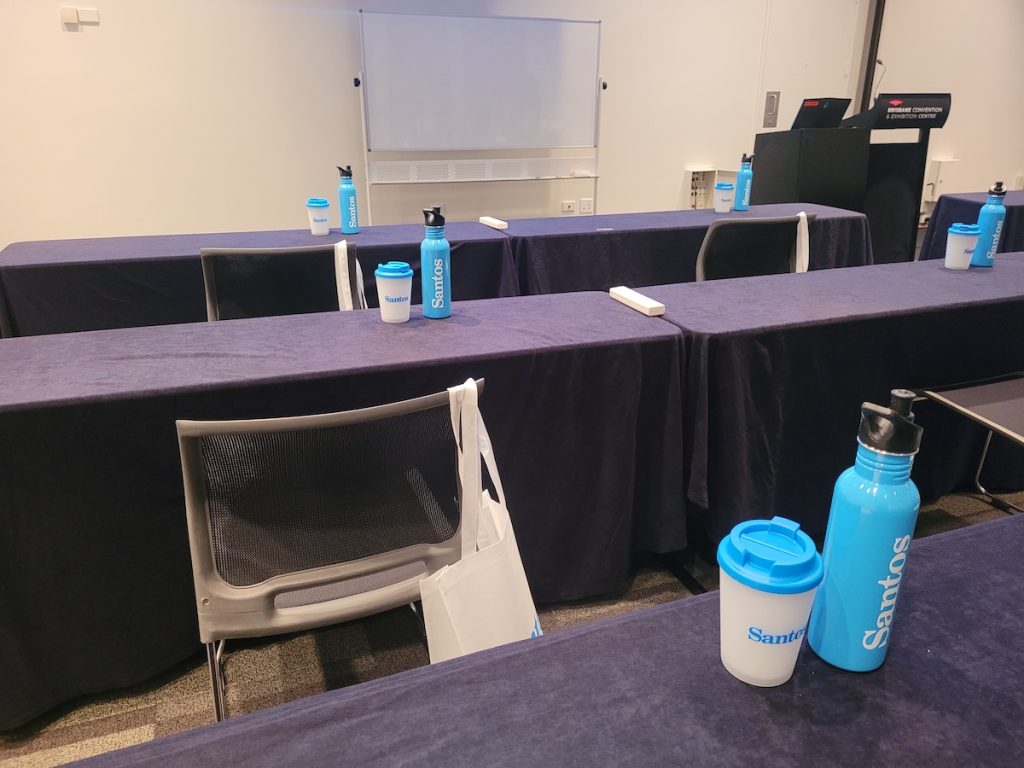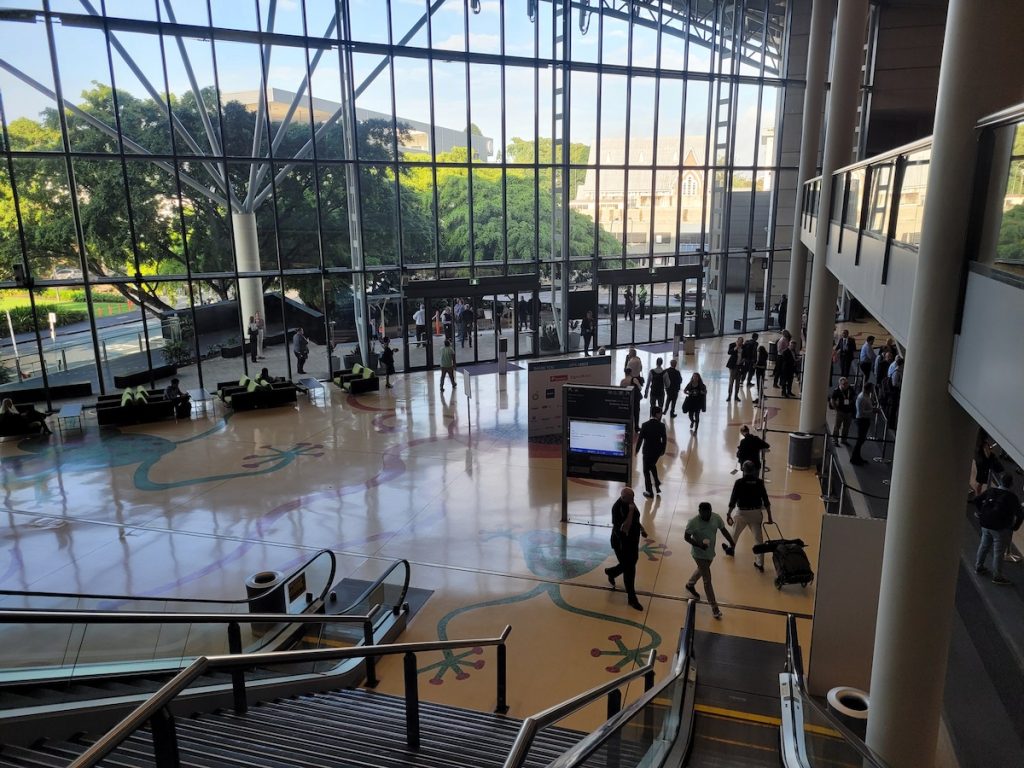Australia's oil and gas companies gathered in Brisbane for their annual conference and the message was clear: they will keep pumping the gas.
An eerie blue light washed the Brisbane Convention Centre ballroom: blue for petroleum, blue for burning gas, blue for blue hydrogen.
It was Wednesday evening in middle-May 2022, day three of the oil and gas industry’s four-day national conference — not counting the golf tournament scheduled for that Friday. The annual Gala dinner was about to begin. The absolute cream of the industry began to gather about an hour before doors opened, forming an impenetrable wall of blue and grey suits in the foyer as they knocked back drinks and developed their professional networks.

Ordinarily tickets to the dinner ran a punter $195 — more than oil companies like Chevron paid in tax over the last seven years.
Earlier that day, the Australian Petroleum Production and Exploration Association (APPEA) media rep had handed me a free ticket saying it was supposed to be a hell of a show. I had flown in 48 hours before to cover the conference. In that time I had been shamed by protesters when entering the building, enjoyed the free lunches in the exhibition hall and browsed the stalls showing off the industry’s best efforts to suck more fossil fuels from the earth’s crust.
Now I was being invited to drink their wine.
It was a casual bit of sleaze, clearly another part of the industry association’s broader media management strategy that included a dedicated media room — sponsored by Santos, the Asia-Pacific’s largest oil company — complete with light pastries, coffee, Santos-branded merchandise, and free cocktails, where the Santos execs could mingle with the nation’s financial press.
Ordinarily tickets to the dinner ran a punter $195 — more than oil companies like Chevron paid in tax over the last seven years. This came on top of the $1,845 APPEA members paid for standard general entry tickets to the four-day conference, or the $2,295 for everybody else.

The Santos-branded merch that was given to all the reporters in the media room. Most left it exactly where it was.
Those who could afford the golden ticket bought themselves unfettered access to the very nexus of wealth and power in Australia, the point in the Venn Diagram where government and industry overlap. On this night alone, those present included representatives from some of the biggest oil and gas companies in the world — those like Exxon, Chevron, Shell — the smaller players, public relations professionals, departmental bureaucrats and elected officials.
At 7pm doors for the sold-out, 85-table event opened and people began to stream into a room that looked like a scene from Bladerunner. Through a blue haze, the words “Together We Shine” — the theme of the dinner and a reference to the song “Shine” by Vanessa Amorosi — were beamed onto two separate screens above the main stage.
It was an unfortunate programming choice. Amorosi had written the song as a teenager and originally titled it “Die” but her production team thought it too dark and it was later changed to “Shine”. The original lyrics read: “Nothing lasts forever/but you can try/look around you/everyone you see/everyone you know/is gonna die.”
Once seated, wine flowed and filet mignon hit the tables as Ian Davies, APPEA chair and Senex CEO began his speech by telling his audience how the world “looks a bit different” to when he last addressed the dinner in 2019.
“Through thick and thin, Queensland’s oil and gas industry has persevered,” Davies said. “In our industry, as in life, the how you do something is just as important as what you’ve achieved.”

The APPEA conference ran days out from the 2022 federal election.
After the platitudes came the awards. To assist in handing out the trophies for environmental and safety excellence that the industry had given itself, the outgoing head of the National Offshore Petroleum Safety and Environmental Management Authority (NOPSEMA), Stuart Smith was called to the stage.
NOPSEMA is the industry regulator and in theory is meant to be the cop on the beat, ensuring these companies play by the rules. When the ceremony was over, Davies heaped praise on Smith and encouraged the audience to applaud him for his eight-year service.
Later, when reporting the story, I asked NOPSEMA why they allowed this spectacle. In a statement they explained they had no issue with Smith appearing on stage during an industry dinner as his contract was up in September. The event offered an opportunity for his “work over the last eight years [to] be acknowledged,” they said.
But that was not all. There would still be one more surprise to come when, after the crowd was nicely toasted, the entertainment for the evening was announced: a private show by Vanessa Amorosi herself.
Cooking With Gas
At this point in human history it is hard not to conclude the oil and gas industry is taking the piss.
At this point in human history it is hard not to conclude the oil and gas industry is taking the piss.
It took 252 million years for the planet’s oil fields to form. Over hundreds of millions of years, plankton, plants, algae and bacteria fell to the bottom of a vast ocean where their bodies became trapped, pressed and cooked by geological processes, working over timescales impossible for the human imagination to grasp.
As they liquified, they transformed into raw crude and the carbon they had consumed in life was buried away for an eternity. Around four thousand years ago, the ancient Greeks wrote of oil springs and began using the stuff to make asphalt while the ancient Chinese became the first to use it for fuel.
The first modern oil well was drilled in Titusville, Pennsylvania in 1859 and over the two centuries of organised extraction that followed, humanity has been steadily releasing all that carbon back into the atmosphere.
No one is sure just how much oil humanity has consumed to date — estimates vary wildly from the hundreds of billions of barrels to over a trillion — but burning fossil fuels today accounts for eighty-six percent of the world’s energy and around seventy-five percent of current anthropogenic CO2 emissions that are destabilising the climate.
Fixing this means the oil and gas industry needs to die.
In April this year the International Panel on Climate Change declared it was “now or never” to address climate change, an act that required moving away from burning fossil fuels. In 2021, the International Energy Agency — a deeply conservative institution feted by Ronald Reagan — said limiting global warming to 1.5 degrees, as set out in the Paris agreement, meant there could be no new oil, gas or coal investment beyond the end of that year.
To date the world has warmed an average of 1.2C and Australia is already reeling. During the Black Summer Bushfires, 8.5 million hectares burned across three states. This was followed by torrential rain that began to fall over Brisbane in 2022 and did not stop. By the time it was over, a muddy swathe of landmass from southeast Queensland down into northern New South Wales was underwater. Lismore, home to 27,000 people, was temporarily wiped from the map — not once but twice.
Yet Australia remains determined to keep pumping the gas. The country may be the twentieth largest oil exporter but it vies with Qatar for status as the world’s top producer of natural gas. As of December 2021, Australia was said to be considering at least 116 new fossil fuel projects for approval and, according to a report by the Global Energy Monitor, had at least six hundred kilometers of new oil and gas pipelines under construction.
Even before the ecological consequences are felt in full, these decisions could spark a financial crisis that makes the GFC look like a bank error. An analysis published in the scientific journal Nature in May found over USD$1 trillion in oil production assets are at risk of becoming stranded as the world transitions away from fossil fuels — and the majority of them are owned by pension and superannuation funds in OECD countries.
In other words, as humanity moves away from fossil fuels, those who are of working age now will be left holding the bag.
Who’s Who Of State Capture
The marketing copy described the conference program as “three days of candid debate on how the oil and gas sector can play a central role in Australia’s future” including a “star studded election panel” on the first day.
At a time when, for most people, writing a letter to their local MP would be met with a form response outlining the party’s policy platform and a promise to “look into it”, it was a testament to the industry’s wealth and influence that attendees heard from a dizzying number of current and former political leaders.
Just attempting to list them felt like trying to draw a corporate chart of the Australian government. They included former Coalition resources minister Keith Pitt, future Labor resources minister Madeline King, and former foreign ministers Julie Bishop and Stephen Smith.
Norwegian ambassador Paul Gulleik Larsen was present for the opening of the conference, while several notable figures attended the gala dinner. In addition to NOPSEMA’s Stuart Smith, there was Queensland Liberal National Party MPs Pat Weir and Trevor Watts, and the Labor MP James Madden who had all been in attendance.
Western Australian deputy premier Roger Cook flew in to attend the gala dinner ahead of a panel on the final day and Queensland premier Annastacia Palaszczuk was supposed to give an address but ended up having her minister for resources, Scott Stewart fill in.

The conference hall on the opening day.
Even Greens leader Adam Bandt made an appearance — to address protesters outside the conference centre.
Even Greens leader Adam Bandt made an appearance — to address protesters outside the conference centre.
For the most part these protesters were ignored and mocked. The dirtiest word in the Australian corporate world is “activist” which loosely translates to “not a serious person” — and the oil and gas industry only deals with serious people. Up on the main stage it sought to project an image of itself as bold, certain and in control of its future.
Away from the glitz of the stage lights and the television cameras, the technical presentations offered better clarity about what they were really thinking about.
They ran four at a time in smaller meeting rooms and covered everything from highly technical discussions about the latest drilling techniques to talks about the future of hydrogen and decommissioning old oil assets — a hot issue for an industry confronting the prospect of its demise.
One talk offered suggestions for how companies may better attract millennials into their workforce. Another discussed the latest research on handling addiction and suicide among oil rig workers — around 190 mining, construction and energy workers die by suicide a year.
There were also two separate presentations covering the legal risks associated with climate change. Neither were well attended.
The second of these was delivered by Anne Freeman, partner with Piper Alderman lawyers, who offered some “practical tips” about what oil companies should do if — or when — they were hit with a class action lawsuit related to climate change.
Her suggestions included “get to know your opponent” to understand how the lawsuit was being funded and “get to know your judge” to “learn a bit about how they’ve previously dealt with class actions”. Freeman then concluded by warning her audience “we’re going to see more of these actions.”
She’s not wrong. According to the Melbourne Climate Futures database recording current and historical climate litigation in Australia, there have been 290 lawsuits to date — the second highest next to the US.
There have been 290 climate-related lawsuits to date in Australia — the second highest behind the US.
Following her talk, Freeman was asked by a member of the audience on whether she thought it was “inevitable that oil and gas becomes the next tobacco” and if so, what she would suggest to stop that from happening.
“We’ve already started to see it,” she said before advising those listening to do their homework, get organised and be prepared.
What War’s Good For
APPEA chair Ian Davies was so good at his job that by the end of his opening address I almost felt an urge to run out and buy shares in Exxon. The existential threat of climate change may be the single greatest issue facing the human species but all he really wanted to talk about was Ukraine.
“We are now in the middle of an energy crisis ignited by Russia’s invasion of Ukraine,” Davies said. “But this is a crisis that has been building for much of the last decade through underinvestment in new and diverse [oil and gas] supply sources.
“The crisis may have started in Europe, [but] the ramifications are increasingly global.”
The thing about spin is that it works by volume. It doesn’t matter if you don’t believe it, what matters is there’s a lot of it and that it’s everywhere. At some point even the most outrageous talking points begin to make a sort of intuitive sense.
Davies had borrowed this particular set of talking points from a campaign being run by his counterparts in the US, the American Petroleum Institute (API) to justify the continued existence of the oil and gas industry. The goal was to head off climate action by weaponising a war in order to sell more gas.
Up until the moment Russian tanks rolled on Kyiv on 24 February 2022 to pursue regime change in Ukraine, financing for new fossil fuel projects had been drying up and governments were starting to make noises about actually beginning the transition away from fossil fuels.
Christine Arena is a former executive vice president of Edelmann, the preferred public relations firm for the world’s biggest fossil fuel companies, who in 2015 resigned in protest over the firm’s continuing work for oil and gas. She says the first rumblings of an effort to link fossil fuels with national security in the public imagination began a day before the invasion began.
“The American Petroleum Institute, which is effectively the fossil fuel industry’s biggest lobbying arm, released these talking points, and they weren’t ordinary talking points,” Arena said. “They were a list of demands.”
An analysis by InfluenceMap, a UK-based think tank which tracks fossil fuel company lobbying, followed what happened next: within hours of the invasion getting underway, the world’s biggest oil companies declared open season on climate action.
Within days they were everywhere. Advertisements published on social media by an API “auxiliary” group carried slogans like “American Made Energy” and were seen by one-in-ten Facebook users in the US. API CEO Mike Sommers averaged at least one interview a day over the first two weeks of March — at one point making six appearances on Fox News in a single day.
Arena says these sorts of coordinated campaigns typically take months of planning. Talking points need to be refined, distributed and drilled; videos need to be shot and edited; art for print and social media advertisements need to be designed; and then every detail of the campaign needs to be approved at the highest levels.
She believes the industry was prepared for an escalation of the conflict and were determined to make US President Joe Biden personally own any ensuing price spike.
“This was the industry with a gun to Joe Biden’s head,” she said. “They were saying: we’re gonna blame these high gas prices on you. We’re going to press for oil and gas expansion and we’re going to attack renewables. As those oil prices come up, we’re going to continue to pin the blame on you.”
With the APPEA conference running days out from the 2022 federal election, where a group of independent candidates were explicitly running on platforms calling for more climate action, Davies threw down the gauntlet.
“The focus of our opponents on stopping fossil fuel projects, frankly, has had no effect on consumer demand. It has had no effect on emissions reduction,” he said. “What it has done is pushed fossil fuel developments to places such as the Middle East and Russia.”
It was an idea that would be repeated in panels discussing what the invasion of Ukraine would do to oil and gas markets, and in presentations like the one given by Santos CEO Kevin Gallagher during a plenary on “the shape of things to come”.
Gallagher, a short man with a broad Scottish brogue, began his talk on day two with a series of tall claims: Australia needed “decarbonisation, not defossilisation”; the world will still be using oil and gas long into the future; there were “simply no alternatives today” to replace fossil fuels used in fertilisers, steel, cement and plastics; and the world needed steady supplies of oil and gas now that Russia had invaded Ukraine.
The “scarcity” of new oil and gas developments was “frightening”, Gallagher said, before warning darkly of “tight supply for some years.”
“Energy security is the foundation of national security,” he said. “What we have on our doorstep is a prime example of what happens if the energy transition is focused only on stopping new oil and gas projects.”
But it was during the ensuing panel discussion that Gallagher, a former APPEA chair, made clear how he was thinking about the future. When asked whether he was worried about the outcome from the 2022 federal election, Gallagher answered with a verbal shrug.
“Not really,” he said. “I think my request is that there be no big knee jerk factors, that there’s no big Biden-type policy announcement on day one, in closing things down, because I think that’d be very disruptive.”
A Rising Shit Tide
I was collecting my bags from the coat-check after the final panel when I overheard them: two tall, white men in blue suits talking about climate change. They were in the corporate hierarchy of one firm or another, and the second was getting really worked up talking about the idea of net zero by 2050.
“It’s bullshit,” he said. “It’s all bullshit.”
The gist was that the world was sending contradictory signals: at the same time it was talking about the need to end fossil fuel production, it was telling oil and gas companies to produce more. For all the guff about how the industry “understands one-hundred percent our obligations to decarbonise”, they had zeroed in on this tension and interpreted it to justify their continued existence.
How could they not? I had just spent three days steeping in the company of men like these. They had devoted their lives to an industry responsible for creating an existential threat to humanity that had to end, but their salaries depended on them refusing to accept that reality. Instead they spoke in doublespeak and wrapped themselves in a comforting illusion — but when they were being completely honest, even they did not believe their own bullshit.
And yet the harm they had caused was happening in real time. The day I had flown into Brisbane the price of petrol hit $2.24 a litre and the friend who picked me up from the airport explained how “technically” the city had flooded four times in as many months.
She and her partner lived in Oxley, the region that elected Pauline Hanson, a climate change denier, to represent them in Canberra in 1996. On the drive back to the Queenslander they rented — a raised structure built to allow floodwaters to pass harmlessly beneath — she pointed out a verdant field and apologised for the smell.
When the city floods and its stormwater system is overwhelmed, she explained, it mixes with sewage and the overflow is discharged into the lake. The residue of humanity bakes there in the Queensland sun as it evaporates, leaving an aroma to waft across the neighbourhood for weeks.
The shit lake was not the only subtle reminder of the way climate change is already beginning to erode the habitability of our cities. The other was the mould.
As the rain fell amid the heat, Brisbane turned into a sauna with successive days of 100 percent humidity. Every surface seemed to sweat, creating the perfect conditions for thick sheets of black mould to appear overnight. The World Health Organisation says there is no safe level of exposure to black mould but bleaching it off walls and surfaces did no good. In 24 hours, it would be back.
It’s been said that the lived experience of climate change is watching terrible things happen to other people on your phone until it inevitably happens to you. This is true, but in between those big, dramatic moments is the day-to-day accumulation of subtle inconveniences which eventually add up to make a place unlivable.
Not even the oil and gas industry themselves could escape this reality. The Australian Oilfield Golf Tournament had been scheduled for the Friday but would end up cancelled owing to the torrential rain.
The competition’s chair, Kylie Carrie, lead analyst with Shell subsidiary QGC, explained with “great regret,” in a note announcing the cancellation, how the torrential rains which had temporarily wiped Lismore from the map had also flooded the Brookwater Golf and Country Club forcing it “closed for a week and still not drained”.
“As most are aware there has been a major weather event over the last week in the greater Brisbane area, significant amounts of rain,” Carre said. “Brookwater have advised that they will no longer be able to accommodate the AOGT for 2022.”
It was a disappointment for the executives who had been hanging out for a morning on the green but it was hard to imagine they would find much sympathy. For the principal actors responsible for driving climate change it was just the cost of doing business and, perhaps, a sign of things to come — for there can be no golf on a dead planet.
This article features in the September 2022 issue of Rolling Stone AU/NZ. If you’re eager to get your hands on it, then now is the time to sign up for a subscription.
Whether you’re a fan of music, you’re a supporter of the local music scene, or you enjoy the thrill of print and long form journalism, then Rolling Stone Australia is exactly what you need. Click the link below for more information regarding a magazine subscription.







































